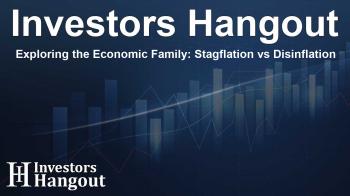Exploring the Economic Family: Stagflation vs Disinflation

Understanding Today's Economic Climate
In the current economic landscape, discerning between issues like disinflation versus stagflation has become quite complex. Recent economic readings have left many confused, as they don't clearly indicate the path ahead.
Current Economic Indicators
Signs of Stagflation
Currently, there are compelling signs of stagnation in our economy, which have not been seen since decades ago. Recent data points to this troubling trend:
- Key statistics such as GDP and PCE, along with trade deficits and the housing sector, reveal serious stagnation.
- There’s been an uptick in inflation even as consumer spending and wages experience a decline.
- Oil prices are a crucial factor; they remain elevated, suggesting potential price shocks due to high demand.
- Other vital commodities like silver, copper, aluminum, and platinum have also seen rising prices.
- The impact of federal policies and tariffs on inflation remains uncertain, adding another layer of complexity.
- Furthermore, the weakening dollar raises concerns about our economic stability.
- Consumer awareness and small-cap growth are lagging behind, indicating broader economic issues.
Evidence Supporting Disinflation
Contrastingly, there are also signs of disinflation reminiscent of the economic strategies of the 1980s:
- Tech stocks have recently peaked, indicating investor confidence in growth.
- Food commodities are becoming more affordable.
- The fluctuating oil prices could also decline, contributing to lower inflation rates.
- As the Federal Reserve considers rate adjustments, the economy might stabilize if prices halt their climb.
- Though consumer confidence could be better, it is not entirely negative.
- Interestingly, the transportation sector appears to be on a resurgence.
- While there are job market declines due to AI, these shifts may not necessarily signal traditional employment weaknesses.
- Long-term bond yields have started to drop, indicating a potential market shift.
What is the Economic Family's Stance?
In this debate about stagflation and disinflation, it seems that many in the economic sector are swaying towards the disinflation narrative despite the looming inflation risks. Yet, there are noteworthy exceptions.
Examining the tech sector offers an interesting perspective; semiconductor stocks have recently surpassed their performance boundaries, demonstrating strong momentum despite overall economic concerns.
Market Analysis and Predictions
Market patterns reveal some pivotal moments in various sectors:
- The semiconductor sector, represented by certain ETFs, is likely to maintain upward momentum if it clears its previous highs.
- Retail sectors need to demonstrate resilience and adaptability to cope with potential economic shifts.
- Transportation and small-cap stocks are expected to show stronger performance, bolstered by federal incentives.
- Optimism about U.S. economic policies and tariffs will play a crucial role in shaping market sentiment.
Key Takeaways for Investors
As an investor, navigating through the current economic waters requires vigilance and a nuanced understanding of market signals:
- Watch key price levels across different sectors to gauge potential investment opportunities.
- Monitor economic indicators closely as they can shift the market's trajectory unexpectedly.
- Consider the broader implications of U.S. fiscal policies and global economic events.
Frequently Asked Questions
What are the implications of stagflation on the economy?
Stagflation can lead to high unemployment and stagnation in economic growth, making recovery more difficult.
How does disinflation affect consumer spending?
Disinflation can increase consumer purchasing power as prices stabilize, encouraging spending.
What role do semiconductors play in current market trends?
Semiconductors are crucial for technological advancements, influencing several sectors and their market performance.
Why should investors focus on transportation and small caps?
These sectors reflect consumer demand and economic activity, providing early indicators of market shifts.
How can economic policies impact inflation?
Economic policies, particularly interest rates, greatly influence inflation, shaping the cost structure of the economy.
About The Author
Contact Dylan Bailey privately here. Or send an email with ATTN: Dylan Bailey as the subject to contact@investorshangout.com.
About Investors Hangout
Investors Hangout is a leading online stock forum for financial discussion and learning, offering a wide range of free tools and resources. It draws in traders of all levels, who exchange market knowledge, investigate trading tactics, and keep an eye on industry developments in real time. Featuring financial articles, stock message boards, quotes, charts, company profiles, and live news updates. Through cooperative learning and a wealth of informational resources, it helps users from novices creating their first portfolios to experts honing their techniques. Join Investors Hangout today: https://investorshangout.com/
The content of this article is based on factual, publicly available information and does not represent legal, financial, or investment advice. Investors Hangout does not offer financial advice, and the author is not a licensed financial advisor. Consult a qualified advisor before making any financial or investment decisions based on this article. This article should not be considered advice to purchase, sell, or hold any securities or other investments. If any of the material provided here is inaccurate, please contact us for corrections.

